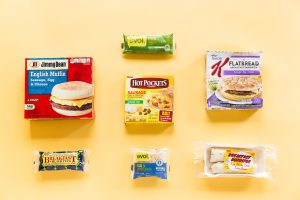If You Choose Wisely
The freezer is part of your pantry. A well-stocked pantry needs things you can use to whip up a meal anytime. But you have to be choosy. Not all frozen foods are good for you. Many of them, especially the single-ingredient ones, like frozen vegetables, can be filled with nutritional dangers.
Frozen Produce
The frozen produce aisle can be a minefield If you don’t read the labels. Dieticians advise using the same criteria for frozen food as you do for fresh. Frozen vegetables that are just vegetables are what you should stock up on. Those are ingredients you can use anytime to help make a nutritious meal. Do not choose those tempting tubs of salt, sugar and fat in frozen side dish vegetables.
The great thing about frozen vegetables is that they are always available. They are processed immediately after harvest and so retain most of their vitamin and mineral content, similar to fresh. Also, frozen vegetables won’t go bad in the crisper drawer.

Use the same criteria for frozen fruit. It’s good to have to add to baked goods, turn into smoothies or top your cereal. Choose packages that don’t have any added sugars.
Frozen bags of whole grains (brown rice and quinoa) and beans (black beans and chickpeas) are making it easier than ever to eat more of this healthy food group. Some of these will come with seasonings, so look for the lowest sodium levels.
A Frozen Nutritional Minefield
While frozen foods can be lifesavers, and convenient, and just a microwave burst away, there are pitfalls. However, no frozen food needs to be totally off-limits. Read labels and make sure you know exactly what you’re getting.
Frozen entrées are so very convenient. They can be on the table in just minutes. That’s almost as good as take-out or delivery, but lots cheaper. Of course, the trade-off for that convenience is dangerous levels of sodium, excess fat, and all kinds of chemicals and flavorings. Don’t just look at the beautiful picture on the package for what appeals to you. That’s asking for trouble. First of all, there’s lots of salt, used as both a flavor enhancer and a preservative. Freezing can dull some flavors, so companies use plenty of salt to maintain flavor. But check the label. If it’s more than 800 mg per serving, move on to another choice. Fat is flavor, but too much will harm you. So, watch out for frozen foods that use heavy cream in the sauce, or lots of salty cheese.
The flip side is that the healthier options in the frozen entree aisle often keep the calorie count down by making the serving size smaller. That means some frozen entrees won’t fill you up. If your meal leaves you hungry, you are more likely to reach for some fattening snack. Look for entrees with 350 to 500 calories. If you choose a low-calorie entree, be sure to add a salad and/or fruit to go with it.
‘I Thought Pizza Was Health Food!’
Frozen pizzas are not necessarily a poor choice, especially when you are in a hurry or just don’t feel like cooking. But a Meat Lovers Deep Dish Pizza with extra cheese is a bomb waiting to go off in your heart. Frozen pizzas also are one of the top contributors to our excessive salt intake. But you can make it better. Look for pizzas with fewer than 800 mg. of sodium. Then up the nutritional value by adding vegetables to the top. A handful of spinach, some leftover sausage, another handful of cheese or leftover veggies can all add additional flavor and nutrition, although if you’re concerned about fat maybe skip that extra cheese.
We All Scream For Ice Cream
It’s okay to indulge in that delicious frozen treat once in a while. But you should choose carefully if you’re worried about too much fat. Also, they are usually loaded with sugar. The more toppings and mix-ins, the more sugar and fat. Premium ice creams are especially bad in terms of fat, usually double or more than most because of the higher milk fat content.
An alternate choice would be sherberts, sorbets, and ices, which usually have less fat but often higher calories from sugar.
Beware Of Breakfast Sandwiches
These sandwiches are convenient and tasty, but hardly the best way to start your day, unless you make your own breakfast sandwiches and stash them in the freezer. Eggs are not really the problem here. It’s what goes into the eggs and the bread that’s used. Eggs in these manufactured sandwiches are often combined with processed meat to enhance the flavor. And the bread is usually made from refined white flour.
A better option is the grab some frozen fruit and makepower a smoothie. Or, you can microwave a bowl of oatmeal. Both will have more staying power through the first part of your day than a calorie-heavy sandwich.
Freezer Tips
Just because it’s in the freezer doesn’t mean it’ll keep forever. Ideally, you’ll eat your way through your freezer’s contents within six months. Package food so that air can’t get in (when it does, ice crystals and freezer burn occur) to help it stay fresh longer. One tip is to date your packages when you put them in the freezer, so it will be easy to spot the ones that have lingered too long.







